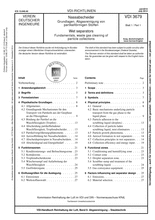Standards Worldwide
Standards Worldwide
Phone +49 30 58885700-07

Technical rule [CURRENT]
VDI 3679 Blatt 1:2014-07
Wet separators - Fundamentals, waste gas cleaning of particle collections
- German title
- Nassabscheider - Grundlagen, Abgasreinigung von partikelförmigen Stoffen
- Publication date
- 2014-07
- Original language
- German, English
- Pages
- 68
- Publication date
- 2014-07
- Original language
- German, English
- Pages
- 68
Product information on this site:
Quick delivery via download or delivery service
Buy securely with a credit card or pay upon receipt of invoice
All transactions are encrypted
Short description
The functional principle of wet separators is based on the transfer of particles from a flowing particle-laden gas stream to a liquid. This presupposes suitable gas/liquid interfaces and a relative motion between the gas and liquid phases. One method of generating the necessary interfacial area and concurrently providing intimate mixing of the gas and liquid is to disperse one phase in the other, i.e. to produce bubble swarms in a liquid or drop collectives in a gas or to use systems in which the liquid is present as a more or less disintegrated jet. Another possibility of contacting the gas and liquid is to pass the gas around wetted collecting bodies. The large number of wet separator variants available is due to the great variety of methods used for generating gas/liquid interfaces and the relative motion between the gas and liquid. This standard deals with wet separation as a process for air pollution control. Wet separators are used for the removal of solid, liquid and gaseous pollutants from gas streams. Pollutant removal is accomplished by collecting the pollutants on the scrubbing liquid injected into the gas stream and separating them from the gas stream together with the scrubbing liquid. There are substantial differences in the removal mechanisms active in the capture of particulates and gas molecules. This standard focuses on processes for the collection of particulate pollutants.
Content
ICS
13.040.40
Replacement amendments
This document replaces VDI 3679 Blatt 1:1998-12 .
Also available in
Loading recommended items...
Loading recommended items...
Loading recommended items...
Loading recommended items...
